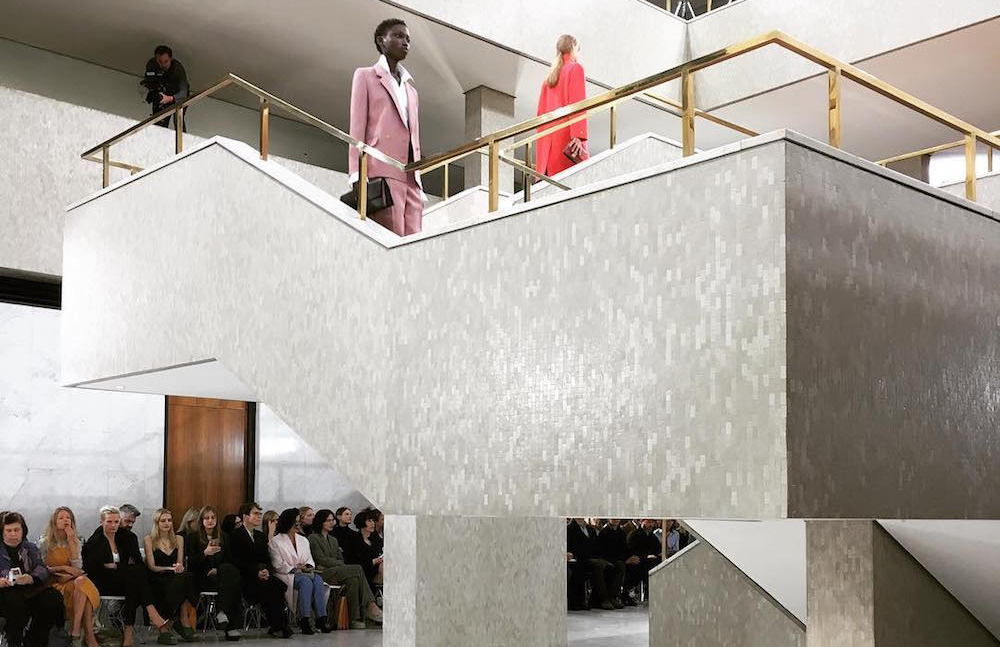London Fashion Week took over everything from Modernist icons to industrial landmarks for the A/W 2016 womenswear collections, offering up a history lesson of the capital’s architecture. Meanwhile, set designers stepped in to make bold interventions, creating lively clashes between old and new.
Mary Katrantzou
Katrantzou’s show united an unlikely mix of references, ranging from Romeo & Juliet and a prom night to Andy Warhol. Her set – devised by Bureau Betak inside Central Saint Martins – came lined with silver foil, backdropped by square balloons. ‘The set underlines the overriding themes of duality, lovers, and love lost,’ said Katrantzou’s show notes. ‘A foiled set is filled with silver balloons, a recreation of a prom in Warholian mirror.’
Alexander McQueen
Designer Sarah Burton chose Lawrence Hall for the brand’s homecoming (McQueen usually shows in Paris but relocated this year thanks to the impending arrival of the designer’s second child). ‘This is where I did my first McQueen show 20 years ago,’ she said. Burton described the A/W 2016 woman as ‘almost sleepwalking, in a state where reality and dreams become blurred’, which explains the set’s dark, nocturnal drapery.
Erdem
Designer Robin Brown transformed the derelict interior of the Old Selfridges Hotel into a backstage set for a theatre. Erdem imagined a troupe of young actresses heading to an audition and ‘grabbing pieces from different decades – a dress from the 1920s, a suit from the 1940s’, he said.
Christopher Kane
Christopher Kane commandeered Tate Modern’s hallowed Turbine Hall for his A/W 2016 collection, setting his collection against a backdrop of scaffolding – part of artist Abraham Cruzvillegas’ ‘Empty Lot’ installation.
Anya Hindmarch
The colourful staging of Anya Hindmarch’s show in London’s 1904 Lindley Hall matched the designer’s pixelated, retro game-inspired A/W 2016 collection. Described as ‘giant pixels’, the illuminated boxes put on a light spectacle as much as a fashion show inside the 20th-century building, designed by architect Edwin James Stubbs.
Burberry
Burberry erected its custom show space in Kensington Gardens once more for its new collection, which was available to order immediately after the show. Inside the temporary structure, the runway was more a meandering maze than a catwalk, with groups of benches clustered together in a serpent-like formation.
Eudon Choi
Soho’s 1929 Brewer Street Car Park once again played host to the main BFC Show Space, which was flooded with light via windows in the Art Deco building’s trussed roof. For Eudon Choi’s show, set designer Anna Sbiera-Paléologue picked up on the abstract art references in the collection and threw them across the runway.
Paul Smith
Models made a grand arrival via the mosaic-lined central stairwell inside the Royal College of Physicians. Denys Lasdun designed this Grade I-listed Modernist edifice in the 1960s, creating a foyer in a palette of marble, dark teak and concrete that perfectly offset the softness of Paul Smith’s dusty pink, navy and rust collection.
Joseph
Joseph took to the raw surrounds of the Brutalist 180 Strand – designed by Frederick Gibberd – for its knitwear-centric AW16 collection, which cosied up to the building’s concrete shell.
Mulberry
Mulberry looked to the past for its first collection under the leadership of new creative head Johnny Coca. Set in the Grade I-listed Guildhall – originally built in 1440 – the show drew inspiration from Shakespeare and, according to show notes, ‘the playwright’s capacity to replicate all echelons of society; from the noble to the nobody, the royal to the rebel’.























